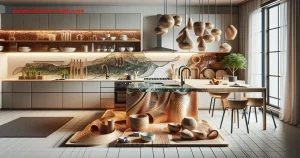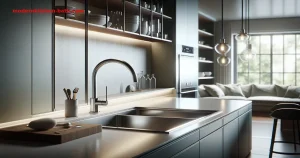Introduction to Japandi Bathroom Interiors
In the quest for serene and functional living spaces, the Japandi style has emerged as a captivating design trend. Combining the minimalist elegance of Japanese aesthetics with the warmth and practicality of Scandinavian design, Japandi interiors offer a unique blend of tranquility and comfort. This fusion is particularly well-suited for bathrooms, transforming them into personal sanctuaries. We delve into the core elements of Japandi bathroom interiors, providing insights and inspiration for creating your own peaceful retreat.
Key Elements of Japandi Bathroom Design
1. Natural Materials
One of the defining characteristics of Japandi design is the emphasis on natural materials. In the bathroom, this translates to the use of wood, stone, and bamboo. Wood, especially light-toned varieties like birch or oak, can be incorporated through vanities, shelving, and even wall paneling. Stone elements, such as granite or marble countertops, add a touch of luxury and grounding. Bamboo is an excellent choice for accessories like bath mats, towels, and storage containers. These natural materials create a sense of warmth and connection to the outdoors. For instance, consider using a bamboo bath mat, widely available online.
2. Minimalist Fixtures
In line with the minimalist principles of both Japanese and Scandinavian design, Japandi bathrooms feature clean-lined, uncluttered fixtures. Opt for simple, geometric shapes for your bathtub, sink, and toilet. Wall-mounted fixtures can help save space and enhance the feeling of openness. Faucets and showerheads with sleek, modern designs contribute to the overall aesthetic. The focus should be on functionality and simplicity, avoiding ornate or overly decorative elements.
3. Neutral Color Palette
The color palette of a Japandi bathroom is typically muted and neutral, with an emphasis on earthy tones. White, beige, gray, and light brown form the foundation, while accents of muted greens, blues, or blacks add depth and interest. The goal is to create a calming and harmonious atmosphere. Consider using a soft, warm white for the walls and incorporating darker tones in the flooring or accessories. Plants, such as ferns or orchids, can also introduce natural greenery to the space.
4. Natural Light and Ventilation
Maximizing natural light is crucial in Japandi design. Large windows or skylights can flood the bathroom with sunlight, creating a bright and airy ambiance. If privacy is a concern, opt for sheer curtains or frosted glass to filter the light. Proper ventilation is also essential to prevent moisture buildup and maintain air quality. A well-placed exhaust fan or operable window can help ensure adequate airflow.
5. Thoughtful Storage Solutions
Clutter is the enemy of Japandi design. To maintain a sense of order and tranquility, incorporate thoughtful storage solutions into your bathroom. Built-in shelving, floating vanities, and concealed storage compartments can help keep toiletries and other items out of sight. Consider using woven baskets or wooden boxes to organize smaller items. The key is to create a functional and visually appealing storage system that complements the overall design.
6. Emphasis on Texture
While Japandi design favors simplicity, it doesn’t shy away from texture. Incorporating a variety of textures can add depth and interest to the bathroom. Consider using a combination of smooth and rough materials, such as polished stone and textured wood. Linen towels, woven rugs, and handcrafted ceramics can also contribute to the tactile appeal of the space. The interplay of textures creates a sensory-rich environment that is both calming and inviting.
Practical Tips for Creating a Japandi Bathroom
1. Declutter and Simplify
Before you start decorating, take the time to declutter your bathroom. Remove any unnecessary items and simplify your décor. The less clutter, the more serene the space will feel. Focus on keeping only essential items within reach and storing the rest out of sight.
2. Choose Sustainable Materials
Both Japanese and Scandinavian design philosophies emphasize sustainability. Opt for eco-friendly materials like reclaimed wood, recycled glass, and organic cotton. These materials not only reduce your environmental impact but also add a touch of authenticity to your Japandi bathroom. Refer to resources on sustainable building materials from organizations like the U.S. Green Building Council for inspiration.
3. Incorporate Plants
Plants are a natural fit for Japandi bathrooms. They add a touch of greenery and help purify the air. Choose low-maintenance plants that thrive in humid environments, such as ferns, orchids, or snake plants. Place them on shelves, windowsills, or even hanging from the ceiling to create a natural focal point.
4. Add Personal Touches
While Japandi design favors minimalism, it’s important to add personal touches that reflect your individual style. Display a few carefully selected decorative items, such as a handcrafted vase, a piece of artwork, or a collection of stones. These personal touches will make the bathroom feel more inviting and lived-in.
5. Invest in Quality
When it comes to Japandi design, quality trumps quantity. Invest in high-quality fixtures, materials, and accessories that will stand the test of time. Choose well-made items that are both functional and beautiful. This approach will not only enhance the longevity of your bathroom but also contribute to its overall aesthetic appeal.
Benefits of Japandi Bathroom Interiors
- Creates a calming and relaxing atmosphere: The minimalist design and neutral color palette promote tranquility and reduce stress.
- Enhances functionality: Thoughtful storage solutions and clean lines maximize space and improve usability.
- Promotes sustainability: The emphasis on natural and eco-friendly materials reduces environmental impact.
- Timeless aesthetic: The combination of Japanese and Scandinavian design elements creates a timeless and enduring style.
- Increases property value: A well-designed Japandi bathroom can add value to your home.
Conclusion
Japandi bathroom interiors offer a harmonious blend of Japanese minimalism and Scandinavian functionality, creating serene and stylish spaces. By incorporating natural materials, minimalist fixtures, a neutral color palette, and thoughtful storage solutions, you can transform your bathroom into a personal sanctuary. Embrace the principles of Japandi design and create a space that is both beautiful and functional.
FAQ
What is Japandi style?
Japandi style is a fusion of Japanese and Scandinavian design principles, characterized by minimalism, natural materials, and a neutral color palette.
What are the key elements of a Japandi bathroom?
The key elements include natural materials (wood, stone, bamboo), minimalist fixtures, a neutral color palette, natural light and ventilation, and thoughtful storage solutions.
How can I incorporate Japandi style into my bathroom?
You can incorporate Japandi style by decluttering, using natural materials, choosing a neutral color palette, adding plants, and investing in quality fixtures and accessories.
What are the benefits of a Japandi bathroom?
The benefits include creating a calming atmosphere, enhancing functionality, promoting sustainability, and providing a timeless aesthetic.
Where can I find inspiration for Japandi bathroom designs?
You can find inspiration on design websites, magazines, and social media platforms like Pinterest and Instagram. Also look to resources on the core tenants of Japanese design.







Leave a Comment